Table of Contents
Bacterial colonies are an essential element of microbiology that is relevant today and will likely remain the same. These colonies are utilized to conduct medical research, the development of pharmaceuticals, and use within the industry of food (the healthy ones, naturally) and many more. When a bacterial colony has been established, the first step to do is recognize it by the morphology of the bacterial colony it exhibits.
Introduction
If a sample is brought into the microbiology laboratory. It is then inoculated on an agar dish and then placed in an incubator in order to promote the growth of microbes. Since the appearance of colonies of microbial alters when they grow, the colonial morphology is assessed at a certain time after the plate has been inoculated. The plate is typically examined between 18 and 24 hours after the inoculation However, the timings may vary for slower-growing organisms such as fungi. Microbiologists examine what the look of the colony taking note of specific characteristics like the size and shape, colour as well as consistency and the opacity. A magnifying or hand lens glass is a good way to examine colonies in more clarity.
The the opacity of a colony of microorganisms is described as transparent or translucent. It can also be described as opaque. Staphylococci tend to be opaque, whereas many Streptococcus species are transparent. The general shape of the colony can be described as circular, irregular or punctiform (like spots). The upward or vertical growth of the colony is another distinctive characteristic, is measured by tilting the agar plate towards the side . It is described as flat elevated convex, pulvinate, (very convex) and the umbilicate (having an opening in the middle) and umbonate (having bumps at the center). The edges of the colony can be described in different ways using words like smooth rough, uneven and filamentous. Bacillus anthracis is renowned for its filamentous appearance that is often described as having the appearance of Medusa’s head.
Consistency is measured by manipulating the colony with a sterilized instrument. It is described in terms such as brittle, cream dry, sticky and. Staphylococci are thought to have a creamy texture however, certain Neisseria varieties are sticky and the colonies of diphtheroid bacteria and beta-hemolytic streptococci are usually dry. The bacteria that make capsules typically are thin (mucoid) appearance.
When certain microorganisms grow in blood agars, they can consume blood within the medium, leading to apparent hemolysis (destruction of red blood cells) on the Agar plate. In the colonial morphology, hemolysis can be divided into three kinds: alpha–, beta and Gamma-hemolysis. In alpha-hemolysis, blood is only partially digested which causes the colony’s surrounding area to turn green. the colony to become green. In beta-hemolysis the organism is able to digest the blood entirely, leaving behind a clean space around the colony. Organisms that don’t produce hemolysis are known as Gamma-hemolytic. Clostridium perfringens that causes gas gangrene, is notable for causing the “double zone” consisting of both complete and insufficient hemolysis.
The smell of a particular culture is often thought to be as a part of the colonial character. Although deliberately smelling microbial colonies is not advised, certain organisms have distinctive smells which can be identified when examining the culture. Some of them are Pseudomonas aeruginosa which emits an aroma reminiscent of grapes; Staphylococcus aureus, described as having the smell of old socks as well as Proteus mirabilis which is described as pungent or as chocolate cake.
Other distinct characteristics of colonial morphology include mobility in addition to the production of pigments. Pseudomonas aeruginosa makes the pigments pyocyanin as well as pyoverdin that give colonies greenish sheen. Certain species of Serratia marcescens make the pigment prodigiosin, which is orange-red in color. Organisms that exhibit swarming motility like Proteus species, show concentric growth waves that extend beyond the point of inoculation.
Definition And Importance of Bacterial Colony Morphology
However, firstly, how can one define colony Morphology? The definition is straightforward that is how the colony appears when it is established on an Agar plate. The visual signals that are provided by a cultivated colony of bacterial are a vital tool for microbiologists to recognize and separate them through colony selection for different purposes.
Bacterial Colony Morphology Characteristics
The morphology of colonies is a method to identify bacteria. When you observe the colonies of bacteria the nature of the bacteria can be identified. The most important elements to look for in a colony’s morphology are the following:
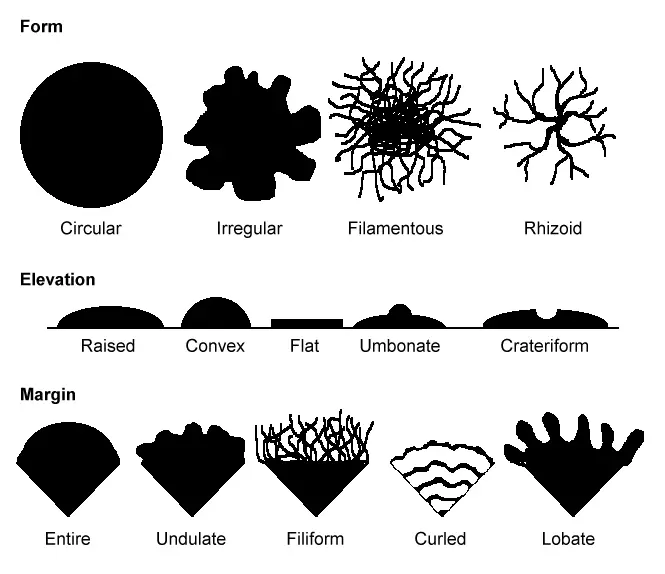
- The size of the colony: The colony’s size is determined by its size as determined in millimeters. The words used to describe the dimensions of the colony are small, pinpoint medium, large, and pinpoint. When the population size organism is greater than 5 millimeters, this is a sign that the organism is motile.
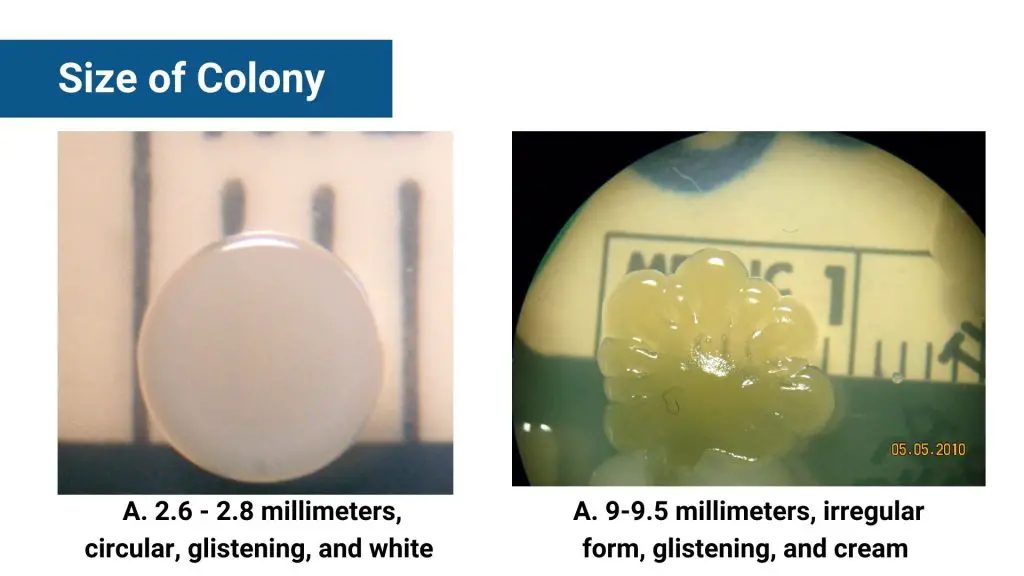
- Surface – refers to how the colony’s surfaces such as smooth, rough shiny, dull, or wrinkled.
- Color: The color of some bacteria create pigment when they grow in an environment. One example of this is Pseudomonas Aeruginosa that produces green pigment as well as Mycobacterium tuberculosis that produces an emerald-colored colony. However, Serratia marcescens produces a red colony.
- Opacity: Opacity refers to the characteristics of the colony , such as:
- Translucent – clear
- Opaque – not clear
- Iridescent – shiny
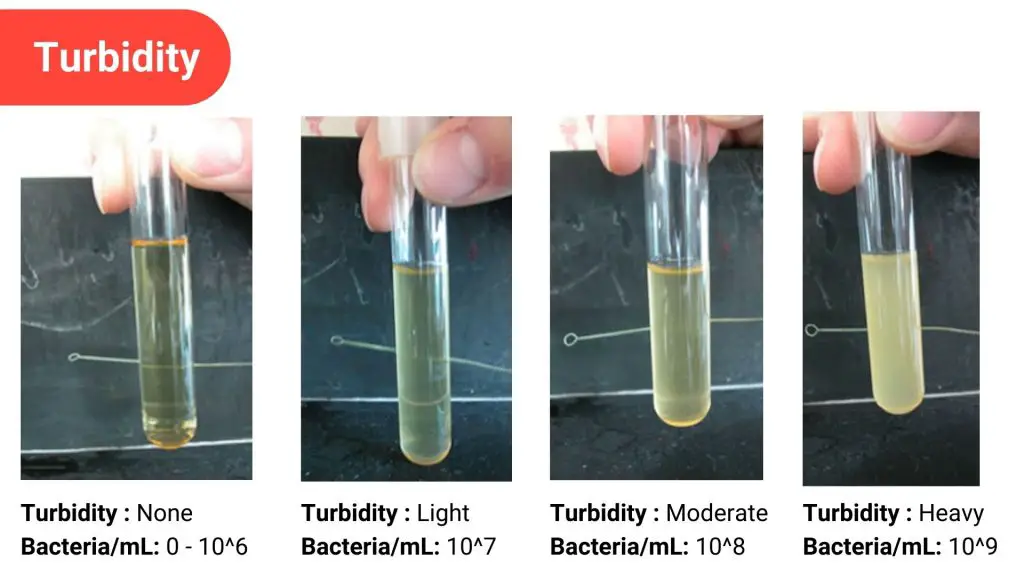
- Elevation – Elevation refers to the cross-sectional form of the colony or the side perspective of the colony, such as:
- Flat
- Raised margin
- Raised
- Umbonate
- Crateriform
- Convex
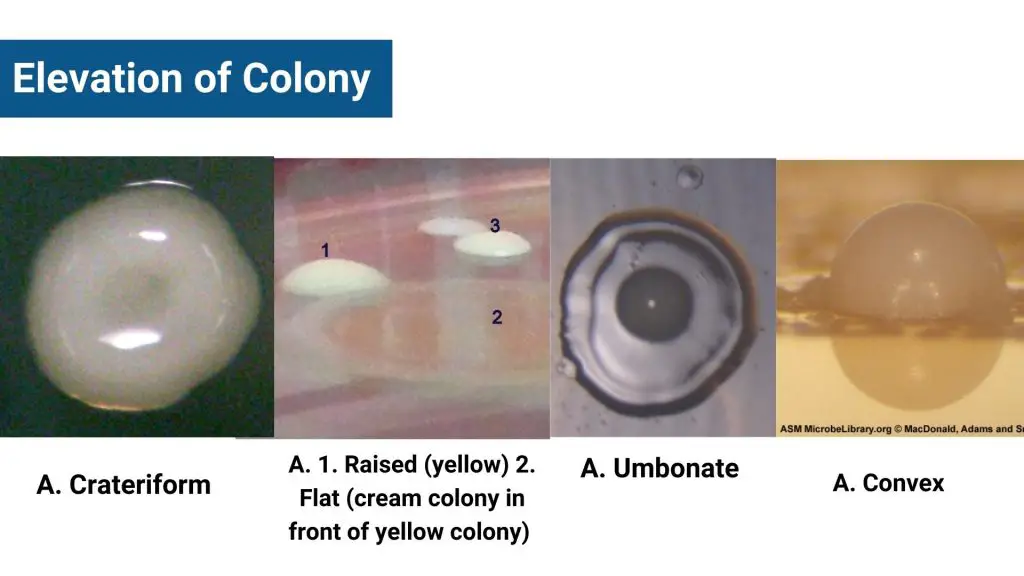
- Margin – It refers to the awe-inspiring shape of the edge of the colony that comprises:
- Entire – smooth
- Filamentous – filament-like
- Undulate – wavy
- Lobate – lobe-like structure
- Scalloped – scallop-like
- Curled – concentric
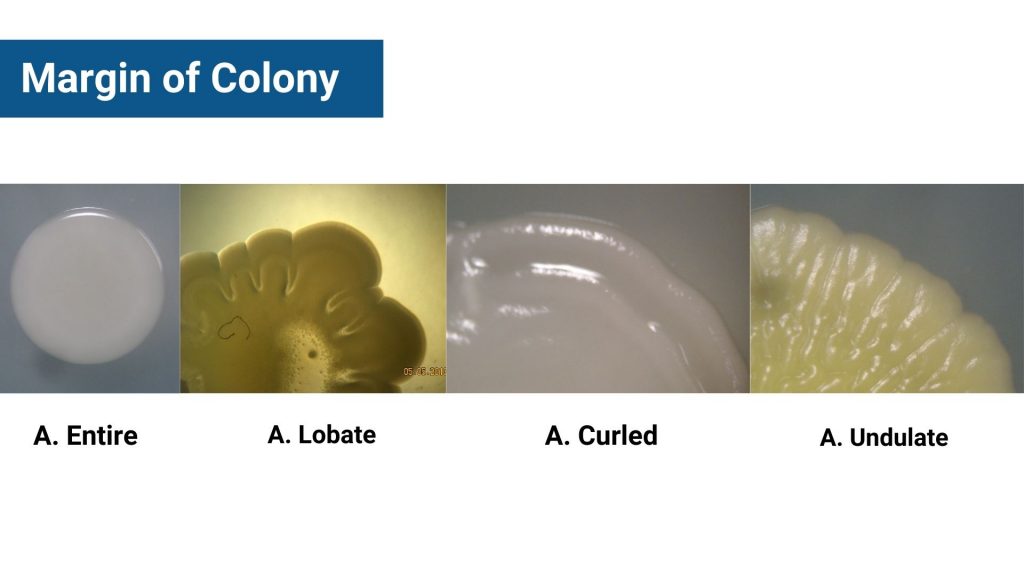
- Pigmentation: Certain bacteria produce pigments. They are of the following kinds:
- Golden yellow (Staphylococcus aureus)
- Lemmon yellow (Micrococcus luteus)
- Prodigiosin( pink/red/ magenata): e.g. Serratia marcescens
- Pyocyanin (bluish-green) e.g. Pseudomonas aeruginosa
- Pyoverdin/fluorescein (greenish-yellow) e.g. Pseudomonas aeruginosa
- Pyomelanin (brown to black pigment) e.g. Pseudomonas aeruginosa
- Pyorubrin (red): e.g. Pseudomonas aeruginosa
- Consistency/texture – Texture and consistency of the living thing is described by:
- Moist
- Dry
- Viscid – stick to loop
- Mucoid- mucus-like
- Odor: Odor according to the its smell, it’s among the following types:
- Sweetish
- Aromatic
- Fishy
- Seminal
- Others
- Shape – The shape of a colony of bacteria may manifest in a variety of shapes that range from but not be limited to the following:
- Coccus/cocci – Bacterial cells which are spherical and resemble tiny balls. An excellent example is Streptococcus aureus.
- Bacillus/bacilli – Bacillus/bacilli are rod-shaped bacteria that resemble a pill. One of the best examples can be found in Bacillus anthracis.
- Spiral – They are spiral or helical in shape that resembles little corkscrews.

- Arrangement of cells – Cell arrangement Bacterial cells are placed in the following order:
- Singly – single cell
- Diplococcic – The cells are placed in pairs and linked to each other. chains long and linked to one another.
- Staphylococcus – irregularly placed in clusters or grape-like
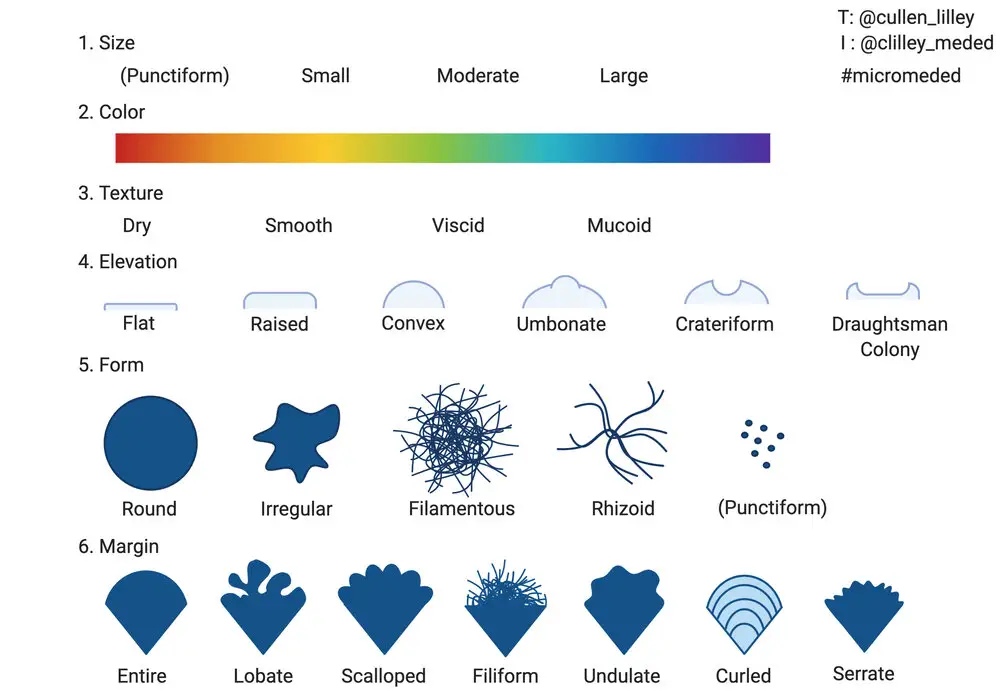
Which Microorganisms can grow on a nutrient agar plate?
Microorganisms like bacteria thrive on solid media as part of colonies. A colony is what? It is an apparent mass of microorganisms that is derived from a single mother cell.
The morphology of the colony of an organism is essential to identify it. Different organisms can thrive within solid substrates. These include:
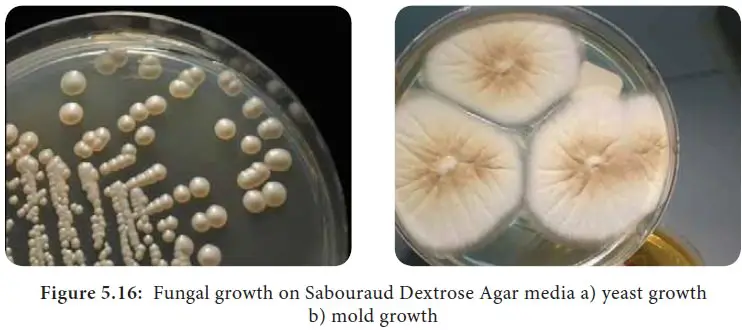
- Bacteria – A colony made up of bacteria typically appear in colors white cream, yellow, and white. In terms of design, the bacteria colony tends to be quite circular.
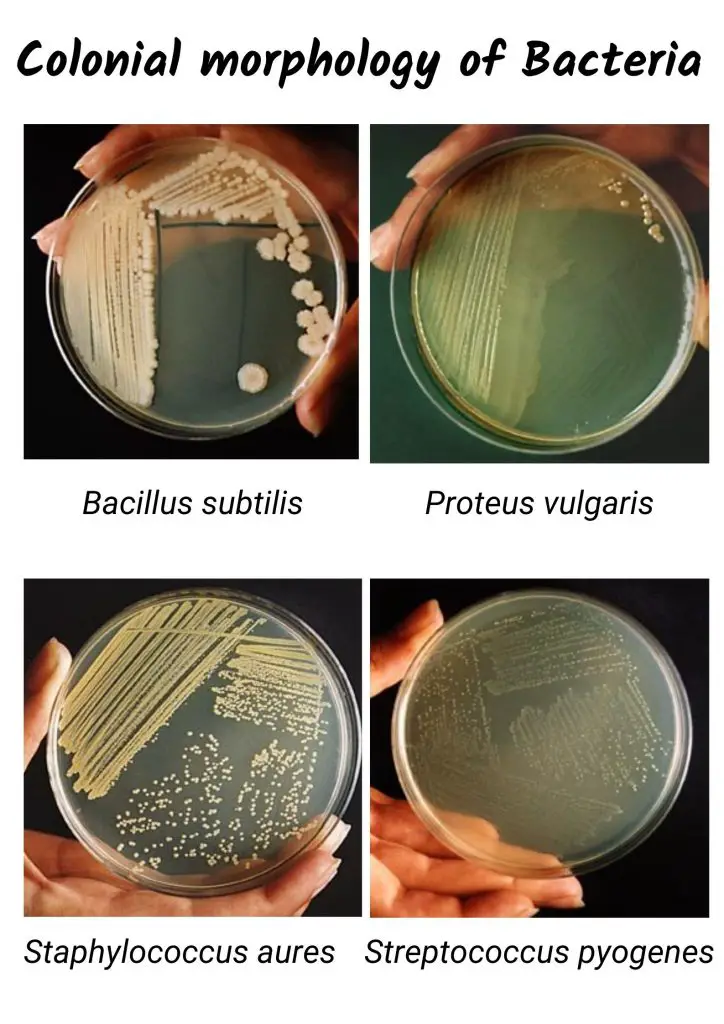
- Yeasts – The colonies of yeast, an fungus type It is a bit like the colonies of bacteria. They may form an uncolored patch that has shiny surfaces.
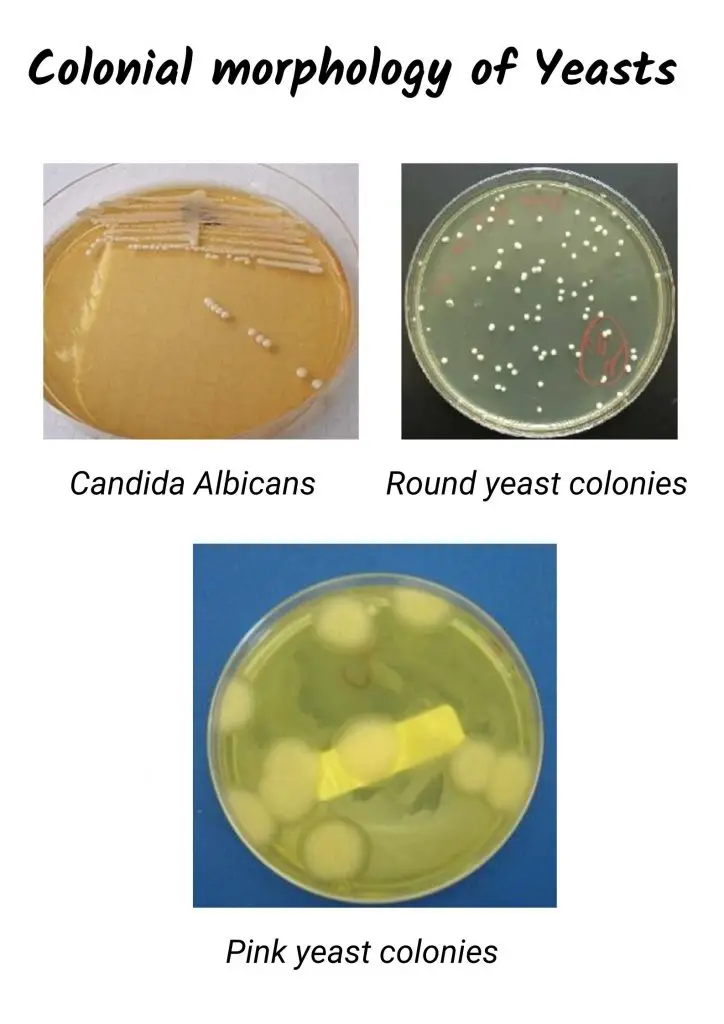
- Mold – It’s a kind of fungi which usually shows a greyish whitish color and has fuzzy edges. It usually changes to a new hue.
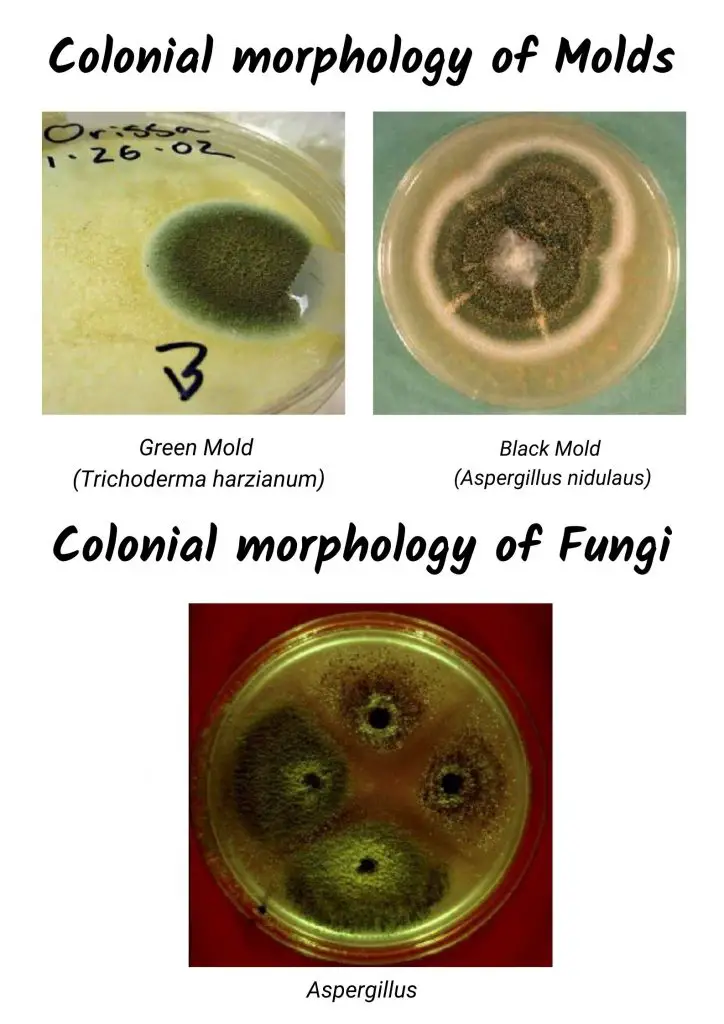
Factors affecting the colony morphology of bacteria
- Media type: The cultural traits of bacteria are affected by the media type and the nutrients it is a source of. Be aware that certain kinds of media have more nutrients than others. The more nutritious the media, the more likely it is to encourage vigorous growth. However certain kinds of media are able to limit the growth.
- Temperature – Some bacteria develop faster at body temperatures and others grow slower at room temperature. In addition, certain bacteria produce pigment when they are at a favorable temperature.
- Time of incubation – The duration of the incubation period can affect colonial characteristics and the size of the bacteria.
- Other organisms present – Bacteria’s growth may influence the development of the bacteria due to the presence of different organisms.
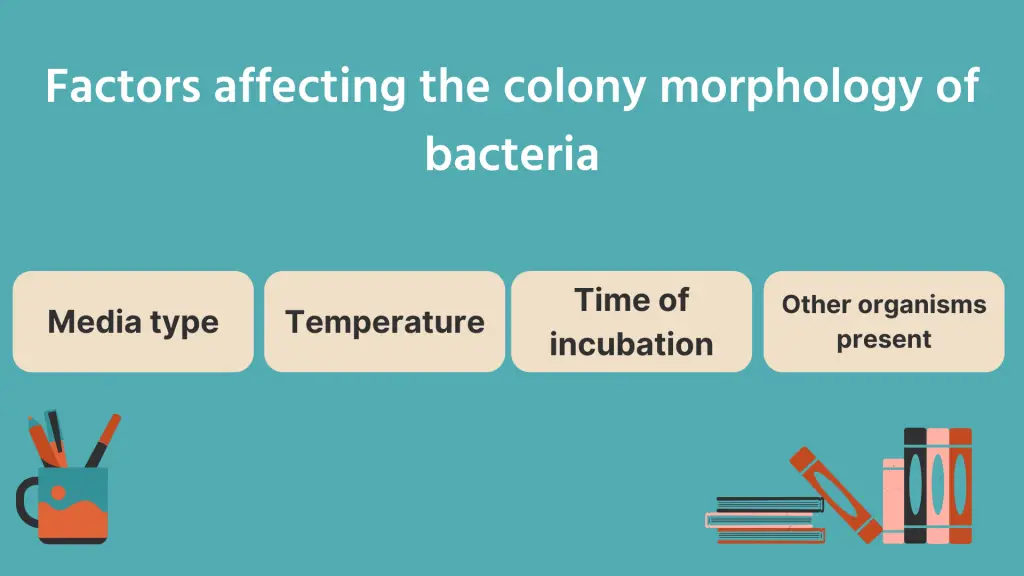
How to Observe And Describe Bacterial Colony Morphology
The study of morphology of bacterial colonies has to be a planned process. The steps listed below serve as a great reference.
- Before you begin to observe the growing colonies, write down the type of medium utilized in the plate used to create the colonies of bacterial. This will serve as a reference point in comparing the morphology of bacteria in a different medium.
- Take a look at the agar plate and look at the various colonies that are on it. Choose a colony that’s well-separated and has a good size so that it’s easy for you to observe.
- Look at the colony’s shape and color. Then, you can look at transparency and appearance. You can make use of magnifying glasses for this, if you’d like. Alternatively, to get the best view of the colony, use a dissecting/stereoscopic microscope and put the agar plate under the lens with the cover closed. Clean the interior of the cover, if it’s condensed prior the observation.
- The plate can be tilted to view your colony from the sides to see the margin and elevation. Odor is often an optional morphology that you can note down, however you may have a sniff from a small distance to record this (and in the event that it’s not dangerous).
- To determine the the texture, you can make use of an inoculating loop or a needle to take a look at the colony and observe its consistency after it is removed from the medium. Once you’ve recorded all the above, you’ll be able to identify the morphology and shape of the colony you’ve selected.
Nature of bacterial growth in liquid medium
- If the whole broth appears cloudy and milky, it’s referred to as turbid.
- If cells deposit are in the tube’s bottom, the tube, then the term”sediment” is applied.
- If the growth of the bacterium forms an unbroken or continuous sheet over the broth , it is known as the pellicle
Growth and Colony Characteristics of Fungi
Fungi are eukaryotic living organisms. They can be found in unicellular yeast similar form and in filamentous multicellular cells or molds, while certain varieties are dimorphic. Most fungi prefer to develop in acidic media.
Sabourad Dextrose (SDA) plates as well as Potato Agar plates can be utilized to cultivate general fungi. The acidic properties of SDA Agar can inhibit the proliferation of bacteria.
The main characters to look out for in a colony of fungi is color of the surface, reverse of the colony the texture of the surfaces (powdery or granular, ecolly, velvety, cottony or glabrous) and the topography (elevation or folding, the edges) as well as the growth rate.
Growth and colony characteristics of yeast Candida
The Yeasts are cultivated on the Sabourad Dextrose Agar in a aerobic manner. The yeasts develop into typical pasty colonies , and emit a the yeasty smell. The morphology of the colony is different for different yeasts. They generally have a smooth texture and are bigger than the bacterial colonies that are on SDA medium.
Growth and Colony characteristics of mold Mucor
The Genus Mucor is usually in a range of shades from grey to white and is growing rapidly. The older colonies change from brown to grey due to the formation of spores.
Bacterial Colony Morphology Examples
- A popular bacteria colony that is commonly examined includes Staphylococcus aureus. In an Mannitol salt agar bacteria produces about two to three millimetres in size and circular colonies that have smooth, shiny appearance. They’re usually transparent and golden yellow with a complete margin. They also occasionally emit the “old socks” smell and the texture of “creamy”.
- Another colony used to study can be found in Escherichia coli (E. coli). On a nutrient agar, E. coli forms large, greyish-white, smooth, opaque/translucent discs. Some strains produce mucoid colonies.
- Streptococcus pneumoniae colonies appear shiny if the bacteria are protected by a glycocalyx capsule. The colonies appear rough when they are in strains that don’t contain capsules.
- The colonies of Bacillus subtilis seen in the image to left are motile. They are equipped with flagella, which allows the bacteria to travel. The descendants then expand from their parents leading to massive colonies with wavy fringes that are lobed.
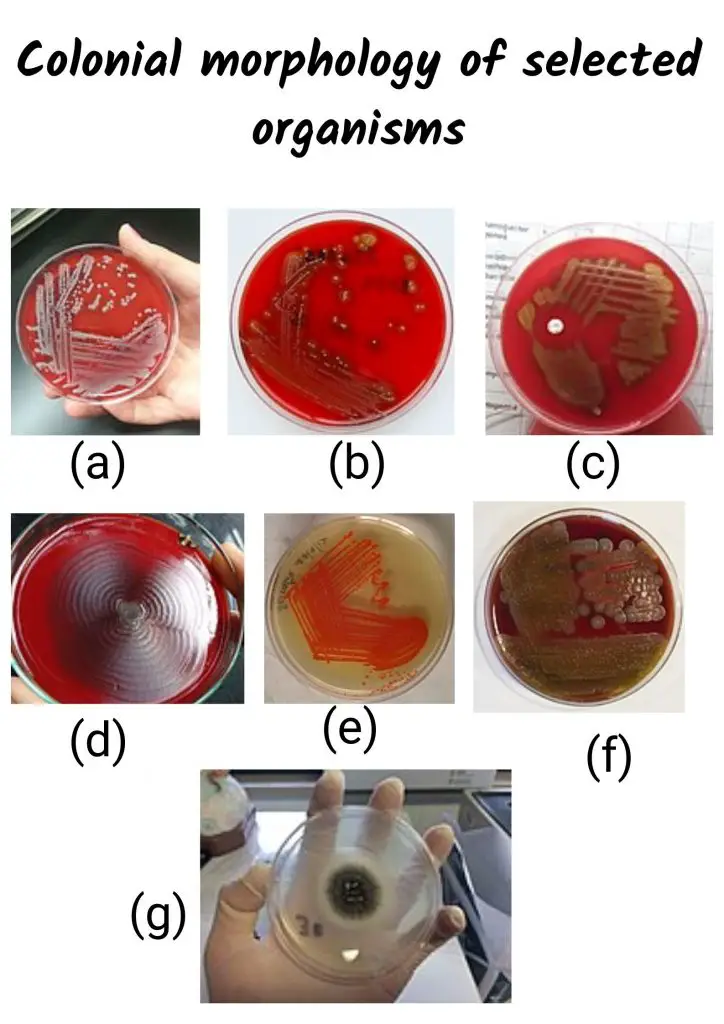
Colony Morphology of Bacteria Infographic
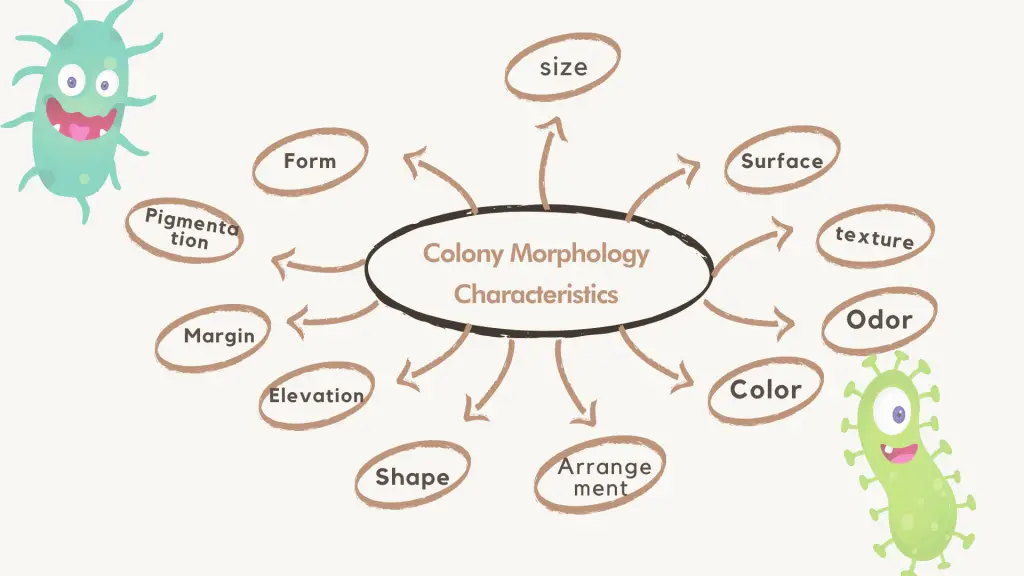
References
- https://hudsonrobotics.com/bacterial-colony-morphology-101/
- https://microbiologysociety.org/why-microbiology-matters/what-is-microbiology/bacteria/observing-bacteria-in-a-petri-dish.html
- https://www.cdc.gov/labtraining/docs/job_aids/biochemicals_gram_positive_organism_id/Colonial_Characteristics_Branded_508.pdf
- https://bio.libretexts.org
- https://www.ncbi.nlm.nih.gov/pmc/articles/PMC4671912/
- https://www.ruf.rice.edu/~bioslabs/BIOC318/morphology.asp
- https://www.slideshare.net/HiwrHastear/culture-characteristic-of-bacteria
- https://www.scienceprofonline.com/microbiology/bacterial-colony-morphology-identification-unknown-bacteria.html
- https://guides.baker.edu/c.php?g=303096&p=2022446
- https://www.ruf.rice.edu/~bioslabs/BIOC318/morphology.asp
- https://en.wikipedia.org/wiki/Colonial_morphology
- https://www.sciencebuddies.org/science-fair-projects/references/interpreting-agar-plates
- http://www.uwyo.edu/molb2021/virtual-edge/lab01/colony_morphology.html
- https://microbiologyclass.com/microorganisms-and-their-colonial-characteristics/
- https://www.brainkart.com/article/Growth-and-Colony-Characteristics-of-Bacteria-and-Fungi_35237/
- http://www.medical-labs.net/bacterial-colony-morphology-2-887/
- https://www.pathelective.com/micromeded/bacterial-colony-morphologies
- https://www.researchgate.net/figure/Phenazine-production-modulates-colony-morphology-in-P-aeruginosa-PA14-P-aeruginosa_fig1_23222373
- https://universe84a.com/colony-characteristics/
- https://laboratoryinfo.com/colony-morphology-of-bacteria/
- https://hudsonrobotics.com/bacterial-colony-morphology-101/

